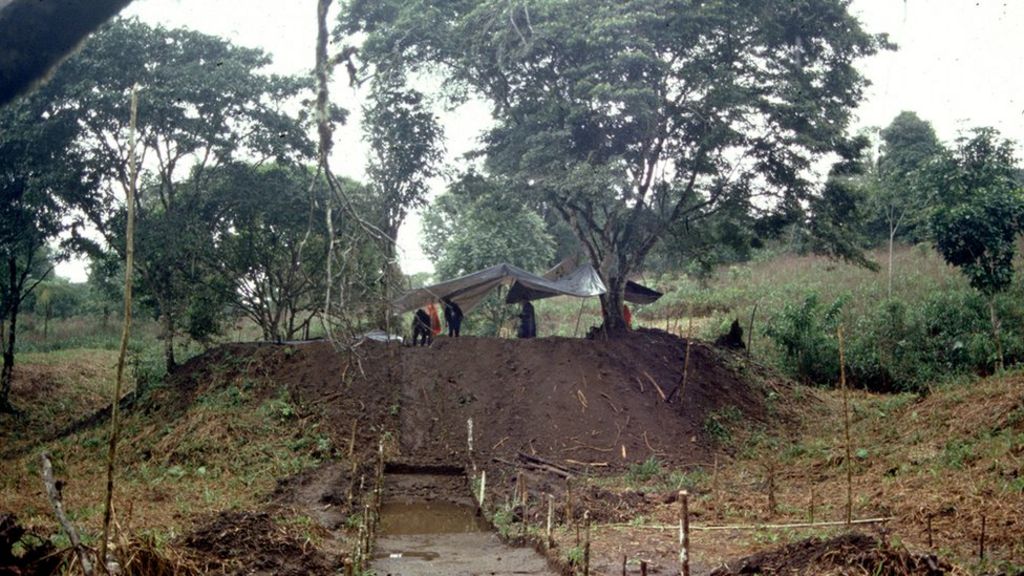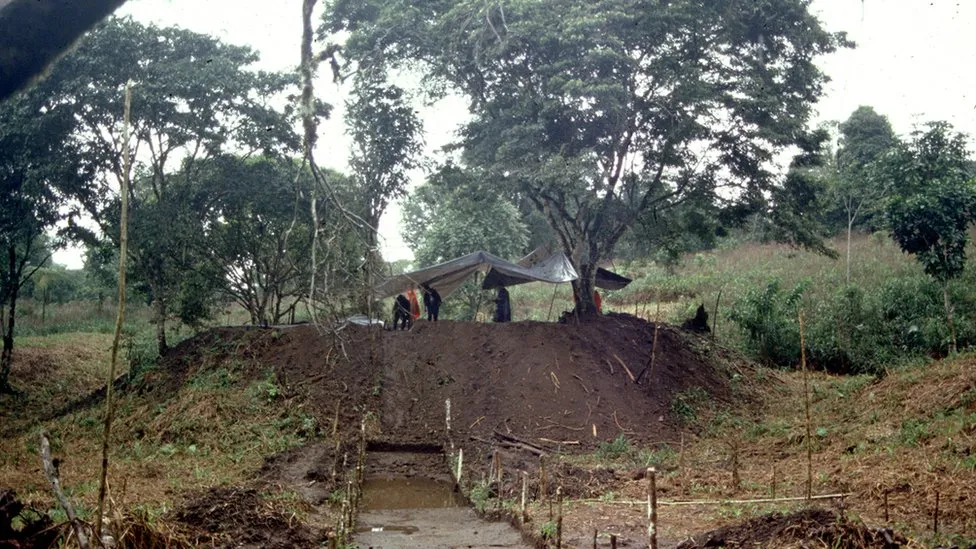Latin America
Related: About this forumAncient cities discovered in the Amazon are the largest yet found
A mysterious civilisation built a network of cities and roads in the Amazon between 3000 and 1500 years ago, and then disappeared
By Michael Le Page
11 January 2024

Lidar scans of the Upano valley in Ecuador showing raised platforms
Stephen Rostain
Aerial surveys have revealed the largest pre-colonial cities in the Amazon yet discovered, linked by an extensive network of roads.
“The settlements are much bigger than others in the Amazon,” says Stéphen Rostain at the French National Center for Scientific Research in Paris. “They are comparable with Maya sites.”
What’s more, at between 3000 and 1500 years old, these cities are also older than other pre-Columbian ones discovered in the Amazon. Why the people who built them disappeared isn’t clear.
It is often assumed that the Amazon rainforest was largely untouched by humans before the Italian explorer Christopher Columbus reached the Americas in the 15th century. In fact, the first Europeans reported seeing many farms and towns in the region.
These reports, long dismissed, have in recent decades been backed up by discoveries of ancient earthworks and extensive dark soils created by farmers. One estimate puts the pre-Columbian population of the Amazon as high as 8 million.
More:
https://www.newscientist.com/article/2411924-ancient-cities-discovered-in-the-amazon-are-the-largest-yet-found/
Also, just posted in Anthropology:
https://www.democraticunderground.com/122910563
![]()
![]()
![]()
![]()
![]()
![]()
Judi Lynn
(162,613 posts)News Direct
December 22, 2023·10 min read
No polished stones, no hatchets, much less an archaeological site. Imposing buildings may have been built with advanced technologies. It is a legacy of the MURIL Civilization for humanity
São Paulo, Brasil --News Direct-- 500NewsWire

São Paulo, Brasil, Dec. 22, 2023 - (500NewsWire) -- Humanity's greatest secret may have been revealed by the Dakila Research team with the identification of gigantic constructions in various parts of the Amazon region. After intense fieldwork carried out over 30 years, scholars defined the main area to deepen research in a portion of the territory of the municipality of Apiacás/MT, which became known as “Quadras de Ratanabá”, as it presents characteristics consistent with the existence of ancient civilizations. For this purpose, LiDAR – Light Detection and Ranging – was used mainly for the equipment that, based on light detection, allows the generation of a digital model of the Earth's surface, characterizing structures and vegetation. Analysis of these results shows very peculiar shapes in the relief that were not sculpted by natural forces.

At this location in Apiacás, streets measuring 60, 70 and up to 90 meters in width and up to 27 km in length were identified, partly covered by sediments left by the last deluge. The courts measure 450 meters wide by 650 meters long and are symmetrically perfect. All measurements were made using LiDAR technology and the GPS device used in the field.
Inside the blocks, the staggered formation covered by soil and vegetation can be clearly observed. It is, without a doubt, the greatest find that humanity has ever had access to. At the end of a few blocks, there are fountains of water that appear unexpectedly and, in a few meters, disappear into the ground, as if they were entering a sinkhole.
Next, a GPR – Ground Penetrating Radar or Geo Radar – was used, which uses high-frequency magnetic waves to locate objects and structures under the ground. Exactly where the water disappears, galleries fifteen meters wide by four meters high and more than a kilometer long were identified, in addition to other neighboring galleries, indicating that the water was channeled into the galleries.
More:
https://finance.yahoo.com/news/scientists-announce-discovery-ancient-buildings-163606724.html
??????????????????????
Judi Lynn
(162,613 posts)11th January 2024, 01:08 CST
By Georgina Rannard
Science reporter, BBC News

Scientists found evidence of 6,000 mounds thought to be the basis for ancient homes
A huge ancient city has been found in the Amazon, hidden for thousands of years by lush vegetation.
The discovery changes what we know about the history of people living in the Amazon.
The houses and plazas in the Upano area in eastern Ecuador were connected by an astounding network of roads and canals.
The area lies in the shadow of a volcano that created rich local soils but also may have led to the destruction of the society.
While we knew about cities in the highlands of South America, like Machu Picchu in Peru, it was believed that people only lived nomadically or in tiny settlements in the Amazon.
"This is older than any other site we know in the Amazon. We have a Eurocentric view of civilisation, but this shows we have to change our idea about what is culture and civilisation," says Prof Stephen Rostain, director of investigation at the National Centre for Scientific Research in France, who led the research.
More:
https://www.bbc.com/news/science-environment-67940671
(My bolding)
Judi Lynn
(162,613 posts)Laser-sensor technology reveals network of earthen mounds and buried roads in rainforest area of Ecuador
Associated Press in Washington
Thu 11 Jan 2024 15.26 EST

This Lidar image shows complexes of rectangular platforms distributed along wide dug streets at the Kunguints site, Upano Valley, in Ecuador. Photograph: Antoine Dorison, Stéphen Rostain/AP
Archaeologists have uncovered a cluster of lost cities in the Amazon rainforest that was home to at least 10,000 farmers about 2,000 years ago.
A series of earthen mounds and buried roads in Ecuador was first noticed more than two decades ago by archaeologist Stéphen Rostain. But at the time, “I wasn’t sure how it all fit together,” said Rostain, one of the researchers who reported on the finding in the journal Science on Thursday.
Recent mapping by laser-sensor technology revealed those sites to be part of a dense network of settlements and connecting roadways, tucked into the forested foothills of the Andes, that lasted about 1,000 years.
“It was a lost valley of cities,” said Rostain, who directs investigations at France’s National Center for Scientific Research. “It’s incredible.”
The settlements were occupied by the Upano people between about 500BC and AD300 to 600 – a period roughly contemporaneous with the Roman empire in Europe, the researchers found.
Residential and ceremonial buildings erected on more than 6,000 earthen mounds were surrounded by agricultural fields with drainage canals. The largest roads were 33 feet (10 meters) wide and stretched for 6-12 miles (10-20km).
More:
https://www.theguardian.com/science/2024/jan/11/amazon-archaeology-lost-cities-ecuador
Judi Lynn
(162,613 posts)CHRISTINA LARSON
,
AP Science Writer
Jan. 11, 2024
Updated: Jan. 11, 2024 1:07 p.m.

1 of 3
This LIDAR image provided by researchers in January 2024 shows complexes of rectangular platforms arranged around low squares and distributed along wide dug streets at the Kunguints site, Upano Valley in Ecuador. Archeologists have uncovered a cluster of lost cities in the Amazon rainforest that was home to at least 10,000 farmers around 2,000 years ago, according to a paper published Thursday, Jan. 11, 2024, in the journal Science. (Antoine Dorison, Stéphen Rostain via AP)Antoine Dorison, Stéphen Rostain/AP
WASHINGTON (AP) — Archeologists have uncovered a cluster of lost cities in the Amazon rainforest that was home to at least 10,000 farmers around 2,000 years ago.
A series of earthen mounds and buried roads in Ecuador was first noticed more than two decades ago by archaeologist Stéphen Rostain. But at the time, " I wasn’t sure how it all fit together,” said Rostain, one of the researchers who reported on the finding Thursday in the journal Science.
Recent mapping by laser-sensor technology revealed those sites to be part of a dense network of settlements and connecting roadways, tucked into the forested foothills of the Andes, that lasted about 1,000 years.
“It was a lost valley of cities," said Rostain, who directs investigations at France’s National Center for Scientific Research. “It's incredible.”
The settlements were occupied by the Upano people between around 500 B.C. and 300 to 600 A.D. — a period roughly contemporaneous with the Roman Empire in Europe, the researchers found.
More:
https://www.myjournalcourier.com/news/article/archeologists-map-lost-cities-in-ecuadorian-18603035.php
(I'll bet the people who lived there didn't know they were living in a lost valley of cities!)
GreenWave
(9,572 posts)where resources are plentiful usually at mouths of fertile river regions. I wondered about the Amazon. I had heard about long term alternate booms and busts in the forest regions of Africa and Latin America. The Amazon is relentless but if in a downward bust the building of structures is somewhat facilitated.
But this was an old theory.
marble falls
(62,580 posts)Judi Lynn
(162,613 posts)
Aerial surveys have revealed the largest 2,500-year-old ancient cities in the Amazon, hidden for thousands of years by lush vegetation and connected by an extensive road network.
The Amazon rainforest was once home to ancient cities, confirms ‘Science’ magazine, which has published a description of Ecuador’s largest and oldest known Amazonian settlement.
An international study published on Thursday, January 11, in Science, reveals a network of garden cities along the Upano River in Ecuador, dating back to 500 BC. It’s the oldest and largest urban network in Amazonia.
It is often assumed that the Amazon rainforest was largely untouched by humans before the Italian explorer Christopher Columbus reached the Americas in the 15th century.
However, the first Europeans reported seeing many farms and towns in the region. Francisco de Orellana, a Spaniard, set out from the eastern foothills of the Ecuadorian Andes at the end of 1541 with a few dozen men, embarking on an amazing river journey that would take them from west to east across the entire continent of South America, ending in the Atlantic Ocean via the Amazon River. Gaspar de Carvajal, a Dominican national, wrote about the dangerous 10-month expedition in which he was ambushed by an Indigenous tribesperson and lost an eye due to an arrow.
More:
https://arkeonews.net/the-amazon-rainforest-was-once-home-to-ancient-cities-a-vast-network-of-2500-year-old-garden-cities/
Judi Lynn
(162,613 posts)Neighborhoods, farms, and roads are 1000 years older than previous discoveries
11 JAN 20242:00 PM ET
BY LIZZIE WADE

A lidar map of the city of Kunguints in the Ecuadorian Amazon reveals ancient streets lined with houses.ANTOINE DORISON AND STÉPHEN ROSTAIN
Archaeologists once believed the ancient Amazon rainforest was an inhospitable place, sparsely populated by bands of hunter-gatherers. But the remains of enormous earthworks, pyramids, and roads from Bolivia to Brazil discovered over the past 2 decades have proved conclusively that the Amazon was home to large, complex societies long before European colonizers arrived. Now, there’s evidence that another human society—the oldest yet—left its mark on the region: A dense network of interconnected cities, now hidden beneath the forest in Ecuador’s Upano Valley, has been revealed by the laser mapping technology called lidar. The settlements, described today in Science, are at least 2500 years old, more than 1000 years older than any other known complex Amazonian society.
Lidar, which allows researchers to see through forest cover and reconstruct the ancient sites below, “is revolutionizing our understanding of the Amazon in pre-Columbian times,” says Carla Jaimes Betancourt, an archaeologist at the University of Bonn who wasn’t involved in the new work. Finding such an ancient urban network in the Upano Valley highlights the long-unrecognized diversity of ancient Amazonian cultures, which archaeologists are just beginning to be able to reconstruct.
Stéphen Rostain, an archaeologist at CNRS, France’s national research agency, began excavating in the Upano Valley nearly 30 years ago. His team focused on two large settlements, called Sangay and Kilamope, and found mounds organized around central plazas, pottery decorated with paint and incised lines, and large jugs holding the remains of the traditional maize beer chicha. Radiocarbon dates showed the Upano sites were occupied from around 500 B.C.E. to between 300 C.E. and 600 C.E. “I knew that we had a lot of mounds, a lot of structures,” Rostain says. “But I didn’t have a complete overview of the region.”
That changed when Ecuador’s National Institute for Cultural Heritage funded a lidar survey of the valley in 2015. Specially equipped planes beamed laser pulses into the forest and measured their return path, revealing topographic features otherwise invisible under the trees.
More:
https://www.science.org/content/article/laser-mapping-reveals-oldest-amazonian-cities-built-2500-years-ago